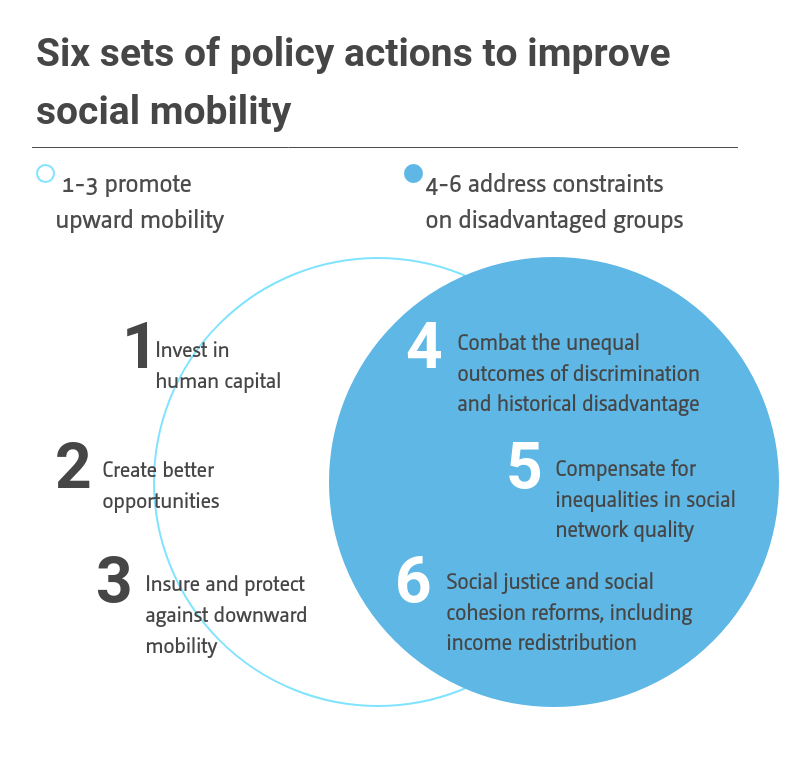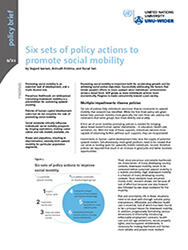Policy Brief
Six sets of policy actions to promote social mobility
Promoting social mobility is an essential task of development, and a multi-faceted one.
Precarious livelihoods are widespread. Containing downward mobility is an important precondition for sustaining upward mobility.
Policies of human capital development assist but do not complete the task of promoting social mobility.
Social networks critically influence individuals’ social mobility prospects by shaping aspirations, making career advice and role models available, etc.
Biases and prejudices, resulting in discrimination, severely limit upward mobility for particular population segments
Promoting social mobility is important both for accelerating growth and for achieving social justice objectives. Successfully addressing the factors that hinder people’s efforts to move upward raises individuals’ achievements across a broad front. GDP grows as more individuals achieve more economically. Progress is made concurrently toward a just society.
Multiple impediments: diverse policies
Six sets of policies help individuals overcome diverse constraints to upward mobility that research has identified. While the first three policy sets given below help promote mobility more generally, the next three sets address the constrains that some groups face more directly and acutely.

A first set of social mobility promoting policies is needed for bringing about broad-based human capital investments – in education, health care, sanitation, etc. With the help of these supports, individuals become more capable of advancing further; without such supports, they are incapacitated.
Investments in human capital development help raise the supply of potential upward movers. Simultaneously, more good positions need to be created that can serve as landing spots for upwardly mobile individuals. Second, therefore, policies are required that result in an increase in good jobs and better business opportunities.
Third, since precarious and volatile livelihoods are characteristic of many developing country contexts, downward mobility needs to be contained before sustained upward mobility is a realistic possibility. High downward mobility is a feature of many developing country contexts. Slum residents have remained mostly static, research shows, not because of lack of effort but because one step forward was followed by two steps backward for the majority.
Risk and uncertainty, rife in these situations, need to be dealt with through suitable policy interventions. Affordable and effective health care is essential, lack of which has been found to be a principal reason for downward mobility. In addition, progressively formalizing various dimensions of informality, introducing enforceable employment contracts, health care and old-age protections, secure property rights, and transparent entitlements, is necessary for making livelihoods and homes more reliable and people more resilient.
Together, these three policy sets, directed, respectively, toward increasing good jobs, achieving gains in human capital development, and containing downward mobility – should help raise the tide overall, advancing upward mobility across a broad front. But the tide does not raise all boats equally.
Levelling the playing field
Research shows that certain population groups do not experience the same kinds of buoyant effects as the rest of the population. Additional policies are necessary for two reasons – because of the important roles that social networks play in individuals’ journeys of social mobility, and because of prejudices and discrimination. A fourth and a fifth set of policies are required for these reasons.
Social networks importantly influence individuals’ mobility prospects, both in tangible ways—via access to opportunities, information about jobs, referrals, etc. — as well as intangible ones: by shaping aspirations, self-esteem and personal efficacy; by bestowing cultural capital; by making role models available; etc. Individuals whose social networks are weakly endowed with high-achieving role models and useful cultural and institutional connections experience severe liabilities to upward mobility.
These are often the very groups, however, whom mobility promotion efforts need to target most directly. Recognizing that capable young people from poorer communities are held back on account of these social network-related reasons, a specialized set of NGOs has emerged in India and elsewhere focused on making these missing inputs available: information about better jobs, career guidance, motivation, mentoring, exposure, etc. Learning gained from these pioneering efforts will help give shape to a fourth set of policies.
Fifth, since certain population groups have suffered discrimination and oppression historically and continue experiencing attitudinal biases, including women in many countries, non-white people in the US and South Africa particularly, former untouchables in India, LGBTQ people, and many others, another set of policies is necessary. Two kinds of policies, those aimed at affirmative action policies and others directed toward longer-term attitudinal changes, are recommended in these situations.
Six sets of policies are required in parallel. The mix of policies in any situation needs to be determined with regard to particular constraints and specific population groups.
Broad-based investments in human capital and actions to increase the number of good jobs are necessary.
Progressively formalizing the informalities that affect jobs and properties reduces risks and uncertainty, making downward mobility less imminent and upward mobility more realistic.
Affordable, accessible, high-quality medical care helps reduce downward mobility.
Helping disadvantaged groups strengthen their social networks requires specialized interventions, current prototypes of which need to be scaled after further study.
Discrimination needs to be countered by a separate set of policies.
Sixth, and finally, it needs to be remembered that policies to promote social mobility have to be seen as part of a broader suite of policies for social justice and social cohesion. A concern with social mobility should not result in a reduction of focus on income redistribution, partly because redistribution may be necessary for achieving social mobility objectives like equality of educational outcomes.
Summing Up
Investing in social mobility through policy investments of these six kinds should be a very important part of the future development agenda. Both growth and social justice will be promoted by enacting these policies.
 Join the network
Join the network